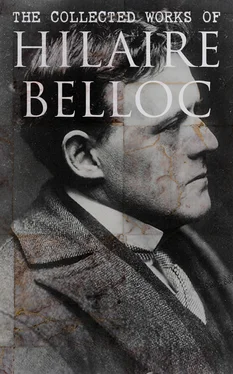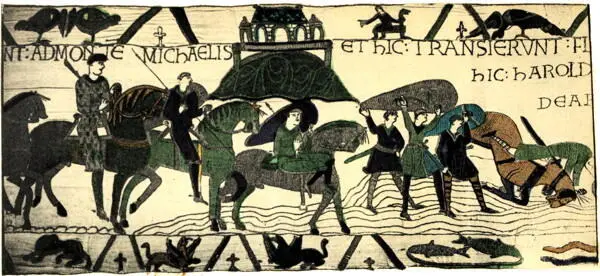
21
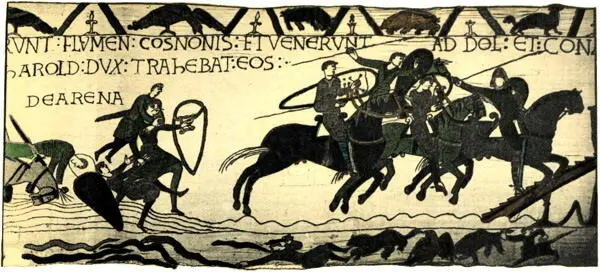
22
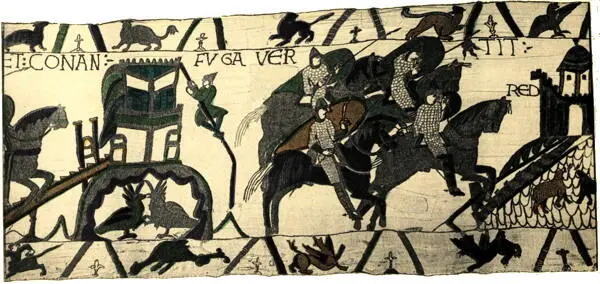
23

24
The river was forded. Men and horses got caught in the quicksands, and in some fashion it was Harold and his men who saved those who were in peril. It is worth pointing out in this connection that there was a bridge at Pontorson, within a few miles of the mouth; why that bridge was not used suggests an interesting conjecture. Perhaps the enemy held it, and William took his force round by the seashore to the north in order to outflank the position.
Conan of Brittany fell back on Dol, and then back again from Dol to Rennes. In the representation of the retreat from Dol you have a man sliding down a rope from the walls, which may be the memory of some incident, or more probably a conventional mark of haste. I presume a retreat upon Rennes, though the only proof of it is the single word “Rednes” and the conventional drawing to represent the town. At any rate, the “hub of the campaign” was at Dinant; the main fight was round the walls of that town, and Conan is represented in the Tapestry as surrendering it. He “offers the keys to William” in the inscription upon this panel.
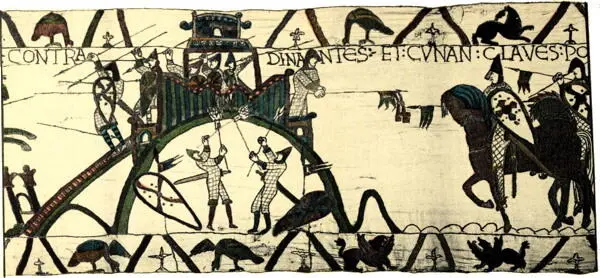
25
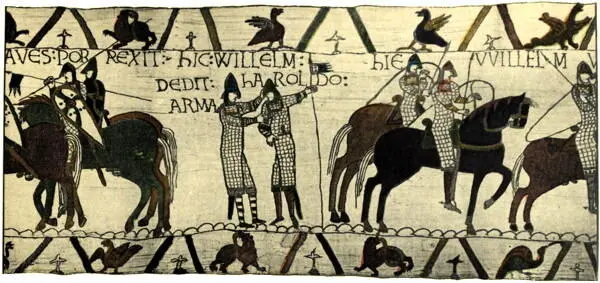
26
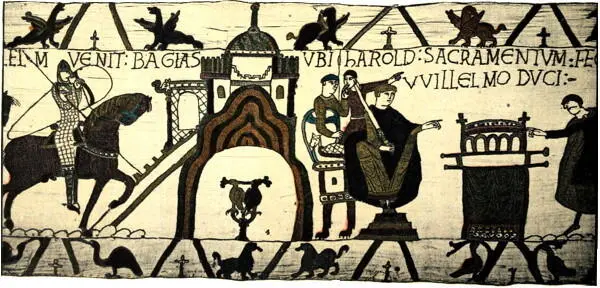
27
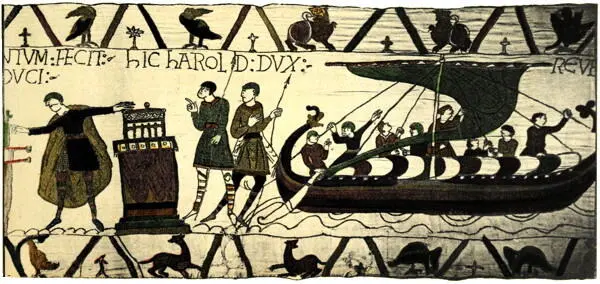
28
Now the very little documentary evidence we have goes to show that this is legend rather than history, and further suggests the comparative lateness of the Tapestry, for William of Poitiers tells us that the expedition was on the whole unsuccessful.
These ten panels of the Breton Expedition (which I desire once more to point out as capital in the whole story—as told in the Bayeux Tapestry) end with a short and simple but critical incident, and that is the giving of arms to Harold by William. The thing was already a ritual and the mention of nothing could have more struck the men of the twelfth century with the closeness of the personal tie between William and Harold, which all this part of the Tapestry is designed to bring into relief. It is symbolised in the 26th panel.
The next two panels (27 and 28) represent what is in popular history the pivot of the whole story, Harold’s oath. It is, of course, the chief single event in the story of what the Norman writers regard as his treason. Note first that the scene is Bayeux. That is important, both because it explains why this favourite town of William’s should also be the custodian of the document before us, and because it again refers us to Wace and the Roman de Rou . Wace is the only author, I believe, who puts down Bayeux as the scene of Harold’s oath. I will give the words from the Roman de Rou that the reader may judge:
“That he (Harold) would give up to him (William) England when the King Edward should die, and that he (Harold) should take to wife, if he willed, a daughter that he (William) had. This, if he would, he should swear. William ... summoned a Parliament 3at Bayeux as people say ,” &c. &c.
William is clothed in all the ritual garments of his authority, garments which were for the rulers of that day almost hierarchic and priestly; he is seated upon a throne, and everything is done by the artist to bring out the solemnity of the occasion. Harold swears with a hand upon either reliquary set upon two neighbouring altars for the purpose of the oath. It is true that the inscription upon the Tapestry tells us nothing of what he is promising upon oath, but we are quite safe in presuming that the story follows Wace and that he is promising the crown of England.
It is, of course, the chief matter of historical dispute in the whole business whether Harold did make that promise or no.
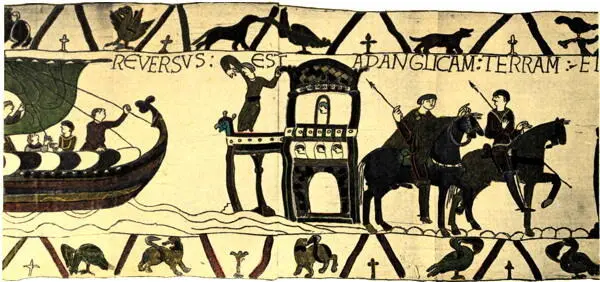
29
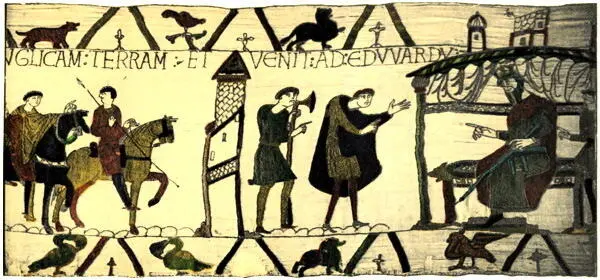
30
In the next two panels (29, 30) Harold crosses the sea, touches English land, and comes again into the presence of his king, Edward. The episodes are not very striking. Perhaps the most remarkable is the conventional building with a sort of pier thrust out into the sea, from which a look-out man watches for the fleet and from the windows of which its arrival is also watched. This building makes the division between the first and second of the panels. It is remarkable that we have no written evidence of this interview between Harold and Edward immediately following his landing; but it must have taken place, and evidently contemporaries took it for granted.
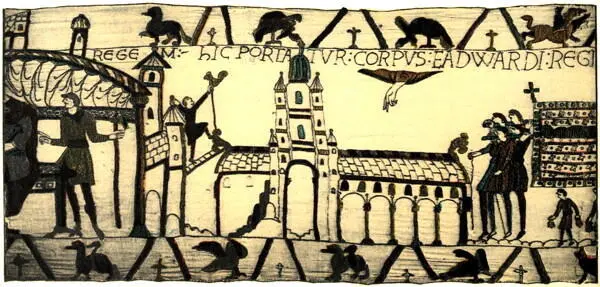
31
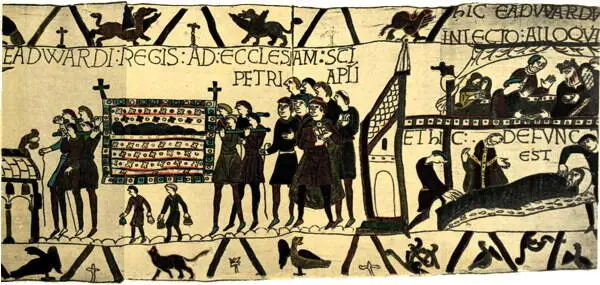
32
The next two panels (31 and 32) are a very curious instance of that reversing of the historical order by the Tapestry, of which we have already seen a minor example in the case of the messengers sent by William to Guy of Ponthieu. What the artist desired to do was to tell, as a separate little story, the death and burial of Edward; but he conceived of it as an episode running from right to left , and the result is that, in the order of the Tapestry, we have the burial actually coming before the death. Take the two panels separately, read them from right to left, and you get a consecutive story; Edward upon his death-bed, in the upper part of the canvas, is speaking his last words to his lieges with the women and the tonsured priests about him. In the lower part he is represented dead. Then, in the second part, to the left, you have the body carried to Westminster Abbey, with acolytes ringing bells and a retinue of tonsured priests. Perhaps the hand appearing from heaven above Westminster Abbey is designed to indicate the sanctity of the king. Nowhere does the Tapestry follow Wace more closely than in these episodes, and even if we had no other evidence to guide us this portion of the Tapestry alone would be almost sufficient to establish the connection between the poem and the embroidery.

33
Читать дальше
